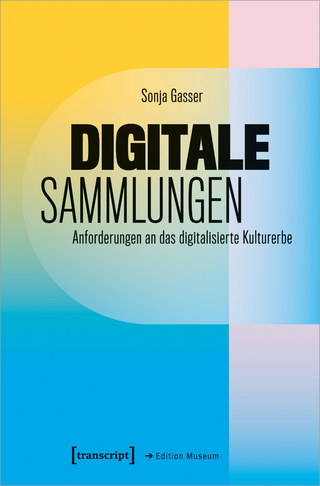
Designing for Empathy
American Alliance of Museums (Verlag)
978-1-5381-1828-3 (ISBN)
Designing for Empathy is a volume of twenty-three essays contributed by multidisciplinary experts, collectively exploring the state of empathy for its design elements that might lead to positive behavior change and a paradigm shift towards unifying, compassionate worldviews and actions.
As museums are currently shaping their tools for fostering empathy as an intentional outcome of museum experiences, the idea of empathy-building is shaping them back as socially relevant institutions that increasingly value diversity, accessibility, and equality. This is a non-linear, multi-layered, and multi-dimensional transformation that requires multidisciplinary, cross-industries, and cross-sectors alliances for its sustainability. The potential of this collective transformation effort includes the invention of unconventional, evidence-based, and sustainable solutions that can be scaled up beyond the walls of traditional museums to all kinds of informal learning platforms to help eliminate the empathy-deficit in our world.
Designing for Empathy expands our understanding of empathy and its potential for fostering compassionate worldviews and actions through a multidisciplinary exploration in three parts: “The Object of Our Empathy” explores how we define and perceive the “Other,” “The Alchemy of Empathy” introduces thirteen design elements of empathy that might lead to transformative learning experiences, and “The Scope and the Spectrum of Empathy” highlights the importance of positioning empathy as a cross-industrial shared value for the benefit of people and the planet.
Designing for Empathy will inspire and empower those who are interested in intentionally designing for empathy to cultivate compassionate worldviews and actions that celebrate and preserve the oneness of all people, the environment, and our planet.
Elif M. Gokcigdem, Ph.D., is the founder of Empathy-Building Through Museums Initiative. She is an innovative thought leader, a historian of Islamic art, and a museums scholar who is committed to creating fertile grounds of empathy through informal learning platforms to inspire positive behavior change, caring mindsets, and compassionate worldviews that value all of humanity and the planet. Gokcigdem is the author of two visionary books on empathy-building: Fostering Empathy Through Museums (Rowman & Littlefield, 2016), and Designing for Empathy: Perspectives on the Museum Experience (Rowman & Littlefield, 2019). She is the chief curator and co-chair of the world’s first museums and empathy summit titled: “Fostering Universal Ethics and Compassion Through Museums with His Holiness the 14th Dalai Lama,” which took place in October-November, 2018 in Dharamsala, India.
Preface
Elif M. Gokcigdem
Introduction
Zorana Ivcevic
Part I
The Object of Our Empathy: How Do We Perceive the Other?
Chapter 1: The Heart
The Heart’s Knowledge Will Never Decay
Dario Robleto
Chapter 2: The Brain
Living Narratives: Neurobiology of Empathy
Erik Jahner
Chapter 3: Conscious Experience
Empathic Space and Shared Consciousness: Museums and the Application of the Spread Mind Theory
Riccardo Manzotti
Chapter 4: The Worldview
Empathy, Narcissism, and Visual Arts Engagement
Sara Konrath
Chapter 5: Augmented Reality
Augmenting Empathy and Decolonizing AR/VR Mediums: How Do We Reimagine Augmented and Virtual Reality Experiences?
Amir Baradaran and Isolde Brielmaier
Part II
The Alchemy of Empathy: Ingredients of Transformative Perspective Change
Chapter 6: Intentionality
Discovering the Power of Art in Forging Empathic Connections
Jon Carfagno
Chapter 7: Intersectionality
Building Transformative Empathetic Experiences to Talk About RACE
Yolanda Moses and Joanne Jones-Rizzi
Chapter 8: Curiosity
Social Inquiry Exhibits: Fostering Social Learning in Museums
Thomas Rockwell, Joshua Gutwill, Heike Winterheld, and Shawn Lani
Chapter 9: Play
Building a Culture for Kindness Through Collaborative Design
Lisa Brahms and Anne Fullenkamp
Chapter 10: Vulnerability
From I to Thou: Transformation Through Traumatic Events
Andreas Heinecke
Chapter 11: Contemplation & Nuance
Found in Translation
Mohamed Zakariya
Chapter 12: Proximity
Designing for Place and People at the Border of Freedom: Niagara Falls Underground Railroad Heritage Center
Seth Frankel
Chapter 13: Storytelling
Empathy in Environmental Communications: Why People Matter for Saving Nature
Anastasia Khoo, Jamey Anderson, and Conservation International
Chapter 14: Synchronicity
Tap Dancing Towards Empathic Communities
Andrew Nemr
Chapter 15: Awe & Wonder
Designing for Wonder: Losing Your Self at the Museum
Nicholas Bell
Chapter 16: Collective Journeying
Religious Pilgrimage and Sacred Relics as Empathy-Builders
Ari Gordon and Menachem Wecker
Chapter 17: Breaking Bread
Breaking Bread and Building Bridges: Repairing Ruptures in Our Communities
Reverend Jennifer Bailey, Lennon Flowers, Emily May, and The People’s Supper
Chapter 18: Optimism & Hope
Optimism to Action: One Smithsonian, the Conservation Commons and the Earth Optimism Initiative
Catherine Christen
Part III
The Scope and the Spectrum of Empathy: Empathy as a Cross-Industrial Shared Value, and Its Potential for People and the Planet
Chapter 19: Ethics & Values
Modeling Decency, Sir!
Elaine Heumann Gurian
Chapter 20: Our Planet & the Environment
The Anthropocene as Our Conscience
Emlyn Koster
Chapter 21: Education & Entrepreneurship
Educating for Empathy: Global Lessons from Schools and Social Entrepreneurs
Dana Mekler
Chapter 22: Innovation & Design
Designing Empathy into Machines: Lessons Learned from Designing Interactions for Autonomous Vehicles
Kursat Ozenc
Chapter 23: Societal Progress
Museums as Incubators of Innovation and Social Impact
Karleen Gardner
| Erscheinungsdatum | 03.08.2019 |
|---|---|
| Reihe/Serie | American Alliance of Museums |
| Sprache | englisch |
| Maße | 159 x 236 mm |
| Gewicht | 916 g |
| Themenwelt | Kunst / Musik / Theater |
| Geisteswissenschaften ► Geschichte ► Hilfswissenschaften | |
| Wirtschaft ► Betriebswirtschaft / Management ► Unternehmensführung / Management | |
| ISBN-10 | 1-5381-1828-9 / 1538118289 |
| ISBN-13 | 978-1-5381-1828-3 / 9781538118283 |
| Zustand | Neuware |
| Haben Sie eine Frage zum Produkt? |
aus dem Bereich


